Friday, February 26. 2010
Almost Everything You Want to Know About the Bloom Energy Box [VIDEOS]
by Ben Parr
 By now, you have probably heard of the Bloom Box, the green fuel cell device that promises to soon power our homes. After appearing on CBS’ 60 Minutes last week, its sand-based fuel cells generated a ton of buzz and media attention.
By now, you have probably heard of the Bloom Box, the green fuel cell device that promises to soon power our homes. After appearing on CBS’ 60 Minutes last week, its sand-based fuel cells generated a ton of buzz and media attention.
Yesterday, Bloom Energy launched the Bloom Box in front of hundreds of investors, press, and well-known figures, including General Colin Powell (who sits on the board), California Governor Arnold Schwarzenegger, and Google Co-founder Larry Page.
What exactly is this energy-generating device, though? How does it work? And when can we expect it in our homes? While we don’t have all the answers to these questions, the press did have the chance to grill Bloom Energy CEO KR Sridhar, Ph.D., General Colin Powell, and others on just what this box is all about.
What Is the Bloom Box?
At the core, the Bloom Box (or the Bloom Energy Server) is an electricity-generating device that takes fuel and air and turns it into power. The buzz is building around the device because it works (several companies are already using them), it is a green technology (low emissions), and that it has the potential to power an entire home with a box that can fit in your hands.
The company behind it, Bloom Energy, hasn’t generated a lot of attention. That is, until it granted its first interview to 60 Minutes last Sunday. The 10 minute clip dives deep into exactly how the box works, the history behind the company (it was founded in 2002), and the potential applications of the device.
If you want to learn exactly what this box is about, check out the 60 Minutes video, embedded below:
Watch CBS News Videos Online
How Does the Bloom Box Create Electricity?
The first question most people ask is: How the heck does the Bloom Box work? While the company understandably isn’t going to reveal its trade secrets, it has provided some nice graphics and details on how the Bloom Box generates electricity.
The device is, in fact, a fuel cell, which means it generates electricity through a chemical reaction. In the case of the Bloom Box, fuel is mixed with oxygen and then a reaction is triggered through an electrolyte layer to create electricity. The actual fuel cells are primarily built with compressed sands. The fuel is interchangeable, although natural gas seems to the fuel of choice currently.
This graphic provides a quick overview of the different configurations of the Bloom Box, as well as the basics of how they work:
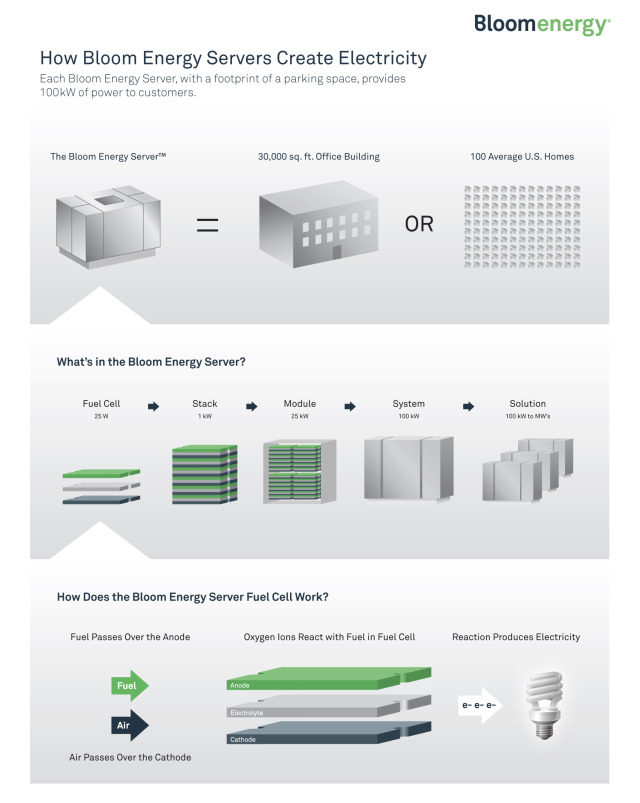
What the Bloom Box Looks Like
The Bloom Box is already in use at eight major corporations: Google, Coca-Cola, Bank of America, Staples, eBay, Cox Enterprises, Walmart, and FedEx. All of these boxes are in California due to a hefty subsidy that helps these companies purchase green technologies on the cheap.
Yesterday, I was at eBay’s headquarters for the launch of Bloom Energy. During that time, I snuck off and took a short video of the five Bloom Boxes currently in use on eBay’s campus. They currently generate about 15% of the power at eBay’s headquarters.
Some interesting things I learned about the boxes by being up-close and personal with them: they are definitely not hot, and while they do make sound, it’s a lot less than what you’d find at a power plant or a transformer station.
Bloom Box Press Q&A
We had a lot of questions about the Bloom Box, and so did the rest of the press that attended the launch of the event. Thus, Bloom Energy had a 30 minute press Q&A to answer our questions, which included Bloom Energy’s CEO and its VP of Marketing, as well as T.J. Rodgers, Founder and CEO of Cypress Semiconductor, John Doerr, Partner at investment firm Kleiner Perkins Caufiled & Byers, and General Colin Powell.
We covered a lot of ground in the 30 minutes, all of which I recorded (apologies for the shaky camera — I lost my tripod!). We asked them about when we’ll see Bloom Boxes in our homes, whether they could be used to power our cars, dived into the technical details of the Bloom Energy Server, how much funding the company has raised (rumored: $400 million), and when Bloom Energy won’t need subsidies to survive.
Bonus: at 19 minutes and 25 seconds, I ask KR Sridhar about which fuels Bloom Energy’s current customers use and learned that the box automatically knows when its fuel input has been changed.
Colin Powell Speaks about Bloom Energy’s Military Applications
-----
Via Mashable
Personal comment:
As a follow up of last week post about the Bloom Box.
Vague Terrain 16: Architecture/Action
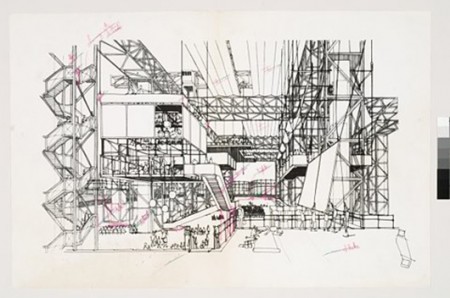
Joshua Noble’s new issue of Vague Terrain is definately worth a look. He described this issue as “an exploration of space, functionality in space, and the relationship of the body to the systems around it. All technologies reshape the body and the space around the body, from the bow and arrow to the steam engine to the telephone. It may be that we are beginning to truly see how computing and ubiquitous devices will once again reshape our bodies and our conceptions of ourselves in space. It is with this emphasis that we present a selection of thinkers, artists, architects, and designers and examine and explore how their ideas will shape art, aesthetics, design, living spaces, and social structures and how those ideas will ultimately be shaped by their users and their spaces.”
Articles have been written by Golan Levin, Jonah Brucker-Cohen, Marilena Skavara, Mark Shepard, Pierre Proske and Joshua himself.
-----
Related Links:
Townshift Competition proposal / Paisajes Emergentes
by Sebastian J.
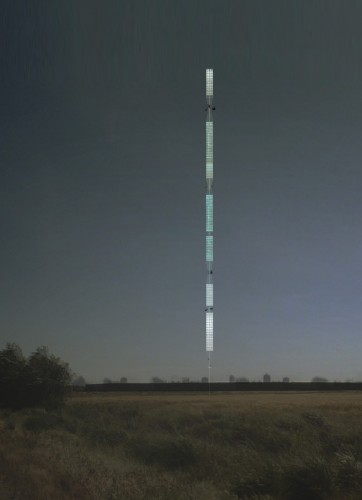
Colombian architects Paisajes Emergentes received second prize for their proposal for the Townshift International Competition in Canada.
More images and architect’s description after the break.
The structure.
Certainly the least interesting thing that a vertical tower can do is to display a welcome sign. Vertical structures can support diverse¨and specialised functions such as communications, energy collection, weather forecasting and are always the most interesting places to experience great views over distant landscapes.
The Fleetwood marker is a dematerialized tower, it is lighter than air and it’s structure ties it to the ground instead of supporting it’s own weight: It is made with clusters of weather balloons filled with helium.
What is interesting about balloons is that with enough cubic meters of helium they can replace traditional static structures based on heavy steel. The tower ends up being lighter than air. It is not a skyscraper, it is more related with a zeppelin or the now common helium balloons used around the world to serve as viewing platforms. It is something that will be affected by the weather, like a vertical cloud, or simply something very strange happening in the sky welcoming the city´s visitors and inviting them to climb up to have a better view of Mount Baker.
The installation:
“We drive an astonishing 6.3 billion miles every day in the U.S. If the kinetic energy generated by moving vehicles was captured at any given moment, it could produce enough electricity to power over a quarter million homes each day.” Fraser highway will be covered with a kinetic carpet systems already available. It’s length will be enough to power the installation and some pilot houses in the city with completely clean energy from the pressure of the passing cars. The vertical balloon clusters of the tower will be in correspondence to the horizontal areas of the highways destined to harvest the energy. The electricity generated by the cars movement will illuminate the installation at night showing a contemplative vertical color light show of what is happening on the highway.
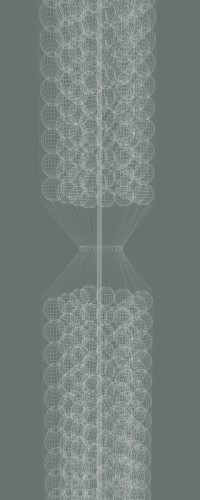
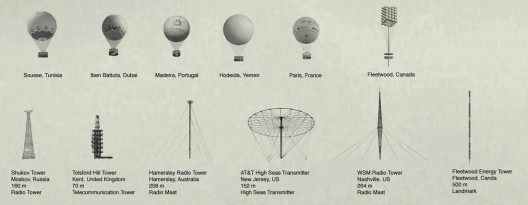
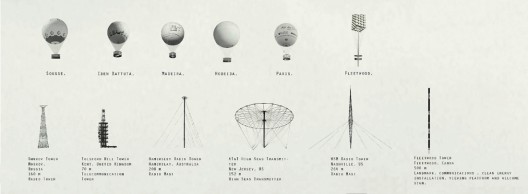

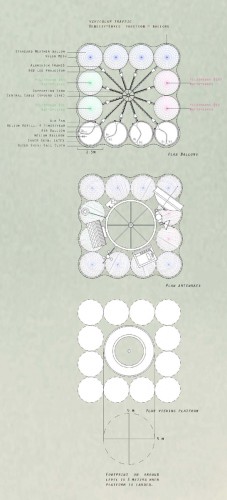
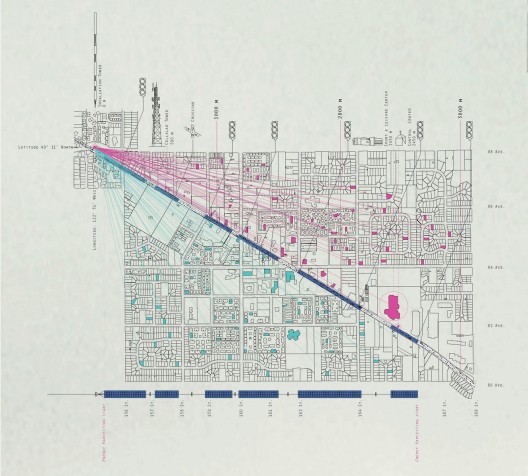
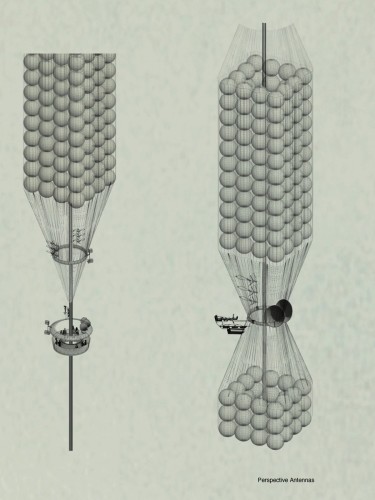

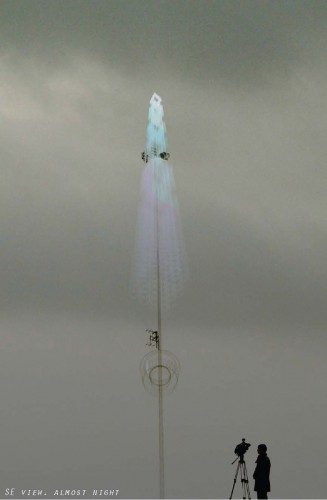
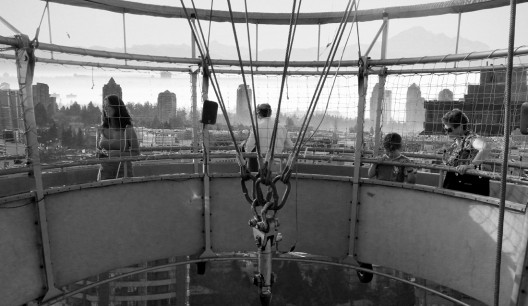

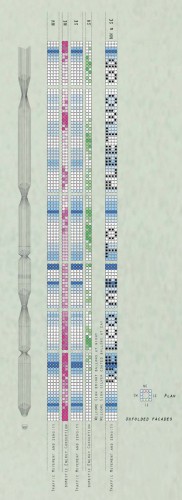


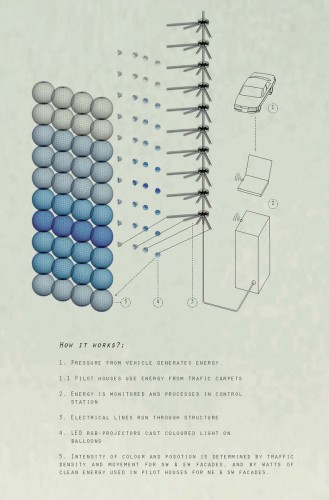
-----
Via ArchDaily
Tuesday, February 23. 2010
Augmented Identity
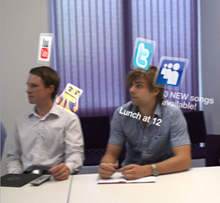 |
| Enhanced image: A prototype app for smart phones matches live images of people to stored profiles and shows icons for social networking sites around their heads. Credit: The Astonishing Tribe |
"It's taking social networking to the next level," says Dan Gärdenfors, head of user experience research at TAT. "We thought the idea of bridging the way people used to meet, in the real world, and the new Internet-based ways of congregating would be really interesting."
TAT built the augmented ID demo, called Recognizr, to work on a phone that has a five-megapixel camera and runs the Android operating system. A user opens the application and points the phone's camera at someone nearby. Software created by Swedish computer-vision firm Polar Rose then detects the subject's face and creates a unique signature by combining measurements of facial features and building a 3-D model. This signature is sent to a server where it's compared to others stored in a database. Providing the subject has opted in to the service and uploaded a photo and profile of themselves, the server then sends back that person's name along with links to her profile on several
"It's a very robust approach" to facial recognition, says Andrew Till, vice president of marketing solutions at Teleca, a mobile software consulting company in the United Kingdom. "It's much, much better than what I've previously seen."
Till says that applying image and face recognition to the trend of posting photos on social networking sites opens up interesting new possibilities. "You start to move into very creative ways of pulling together lots of services in a very beneficial way for personal uses, business uses, and you start to get into things that you otherwise wouldn't be able to do," he says.
Polar Rose's algorithms can run on the
Academic and company research groups have developed augmented reality applications, which superimpose virtual objects and information on top of the real world, for more than a decade. But until the past year or so, all of these prototype applications required bulky headsets and laptop computers. With more powerful sensors, cameras, and microprocessors built into mobile phones, however, augmented reality applications have begun hitting the mainstream. Several apps take advantage of the GPS chips and compasses available in newer smart phones. For example, PresseLite's Metro Paris app and Acrossair's Nearest Tube provide iPhone users with directions to nearby subway stops.
But Gärdenfors calls such applications "relatively crude." They often obscure objects with labels, he notes, and are sometimes limited by the fact that location information may not be available. He thinks that many augmented reality services could benefit from including elements of computer vision to make information retrieval and label positioning more precise. "This could absolutely work for other kinds of objects, and I think we'll see that soon," he says.
However, Gärdenfors notes that using computer vision to identify buildings and other objects holds challenges that they didn't encounter in developing the augmented ID application. "With facial recognition, it's so obvious what you want to search for," says Gärdenfors. "With other objects, it may be harder to tell which item on the screen you want to identify."
Gärdenfors says that TAT has taken potential privacy concerns with the technology seriously from the beginning. "Facial recognition can be a kind of scary thing, and you could use it for a lot of different purposes." For that reason, the company designed Recognizr as a strictly opt-in service: people would have to upload a photo and profile of themselves, and associate that with different
A concept video of the augmented ID application that TAT posted on YouTube last summer garnered a great deal of attention. Gärdenfors says the company often uses this strategy to determine which ideas justify further development. A live demonstration also received a lot of interest at the Mobile World Congress. "We're probably going to partner with some company over the next couple of months to take it to the next level and actually build [a product]," Gärdenfors says. While this will require partnerships with a device maker, a mobile service provider, and social networking services, the technology is developed enough that a commercial application could be ready in as little as a month or two, he says.
Copyright
----
Related Links:
Personal comment:
Is it good or bad news (I remember that the "recognizer" were very evil creatures in the movie Tron ;))? You still need to be part of the system and accept it (apparently) to be recognized, which is good. But if it's as hard as systems like Facebook to sign out, then you might have lost your "right to disappear" for a very long time...
It's again this question of privacy vs. "publicy". Some people prefer to live in "private mode" by default (this was the old "de facto" way of living), while others prefer the contrary.
An Augmented Ecology of Wildlife and Industry
Tiré d'un post plus long sur Mammoth à propos des glaciers --
(...)
Wen Ying Teh’s “An Augmented Ecology of Wildlife and Industry”, a RIBA President’s Medal winning project last year, proposes a hybrid structure — part building, part extension of the ecological process of a saline lagoon — which could be inserted into one of the salt mines near Puerto Ayora, supporting the salt mining industry while restoring the ecological balance of the saline lagoon, drawing Greater Flamingos back to Santa Cruz.
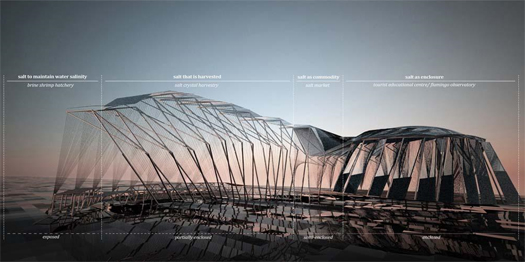
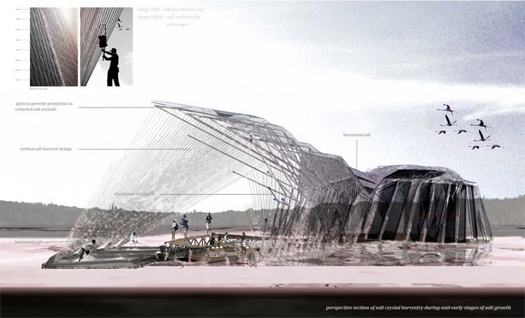
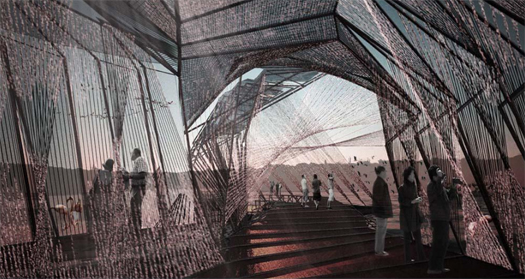
The structure, which hosts a brine shrimp hatchery, salt crystal harvestry, salt market, tourist education center, and flamingo observatory, protrudes linearly into the lagoon before fanning out into a series of tanks housing the brine shrimp. The skin of the structure is composed of hanging nylon threads, which wick salt from the lake through capillary action, crystallizing a mineral skin that is cyclically harvested by the salt miners, so that the building pulses through the seasons with the wax and wane of sodium chloride. Because the miners no longer need to disturb the lagoon to harvest salt, the natural balance of the lagoon can be restored.
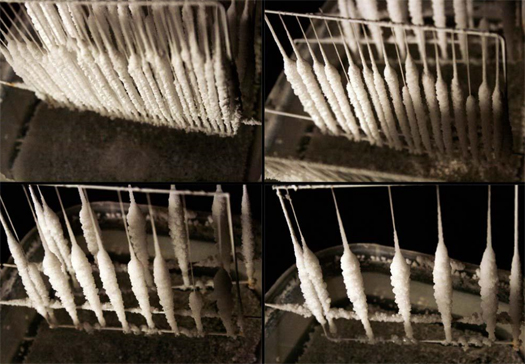

In Wen Ying Teh’s project, the building itself is constituted by processes of accretion and erosion: salt accretes to form the skin through capillary action, and then is eroded, both by harvesting and by rain, with the latter process of erosion being tied into the maintenance of proper salinity for the shrimp hatchery. The structure serves as an extension of the lacustrian ecosystem, not just physically, but in time and process. While in some ways this is an amplification of processes that already occur on buildings — eroding as they weather, accreting objects, paints, memories, and so on as they’re occupied and augmented and built upon — making accretion and erosion not just ancillary to the architecture, but central to it, remains an unusual and beautiful approach.
I first saw Ying’s project at dpr-barcelona; Ying’s tutors were Kate Davies and Liam Young, of the always-interesting Tomorrow’s Thoughts Today.
-----
Via Mammoth
Related Links:
fabric | rblg
This blog is the survey website of fabric | ch - studio for architecture, interaction and research.
We curate and reblog articles, researches, writings, exhibitions and projects that we notice and find interesting during our everyday practice and readings.
Most articles concern the intertwined fields of architecture, territory, art, interaction design, thinking and science. From time to time, we also publish documentation about our own work and research, immersed among these related resources and inspirations.
This website is used by fabric | ch as archive, references and resources. It is shared with all those interested in the same topics as we are, in the hope that they will also find valuable references and content in it.
